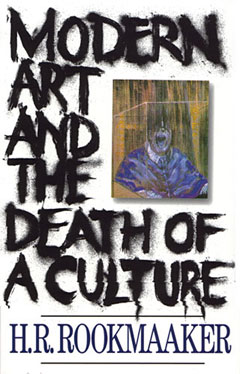 This year marks the 40th anniversary of Hans Rookmaaker’s classic, Modern Art and the Death of a Culture. In his groundbreaking work, Rookmaaker offers pointed perspectives on the counter-cultural turmoil of the 1960s as reflected in its art. He examines histories, themes and reactions in classic and contemporary creative endeavor; and urgently calls Christian artists to bold commitment in executing their unique roles as prophets and messengers. He was impatient with naive questions or lazy, unfocused thinking. Church audiences who blithely dismissed modern art received a not-so-gentle chide: “How can you say that modern art is ugly when you worship the Lord in a building painted like this?” In talks and writing, Hans Rookmaaker sought to address the disastrous severance of truth and beauty from divine revelation. He argued that there is no true beauty divorced from truth, love and freedom, either in art or life. “We are Christians whether we sleep, eat or work hard,” he writes in Art Needs No Justification (1978), “whatever we do, we do it as God’s children.”
This year marks the 40th anniversary of Hans Rookmaaker’s classic, Modern Art and the Death of a Culture. In his groundbreaking work, Rookmaaker offers pointed perspectives on the counter-cultural turmoil of the 1960s as reflected in its art. He examines histories, themes and reactions in classic and contemporary creative endeavor; and urgently calls Christian artists to bold commitment in executing their unique roles as prophets and messengers. He was impatient with naive questions or lazy, unfocused thinking. Church audiences who blithely dismissed modern art received a not-so-gentle chide: “How can you say that modern art is ugly when you worship the Lord in a building painted like this?” In talks and writing, Hans Rookmaaker sought to address the disastrous severance of truth and beauty from divine revelation. He argued that there is no true beauty divorced from truth, love and freedom, either in art or life. “We are Christians whether we sleep, eat or work hard,” he writes in Art Needs No Justification (1978), “whatever we do, we do it as God’s children.”
 Henderik “Hans” Roelof Rookmaaker, art historian, professor, author and lecturer, was born in 1922 in the Netherlands and spent his early years living in Sumatra (Indonesia). After returning to Holland in 1933, Hans developed a lifelong passion for jazz music. Following the German Occupation in 1940, Hans was interned for distributing anti-Nazi leaflets. After World War II, Rookmaaker moved to Amsterdam and studied art history, integrating philosophy with Christian doctrine. He authored many books pertaining to art theory, art history and music. Lecturing throughout the 1960s and ’70s on university campuses and conferences in the U.S. and U.K., he endeared himself to a generation of questioning students. The Papers of Hans Rookmaaker are available to researchers in the college’s Archives & Special Collections.
Henderik “Hans” Roelof Rookmaaker, art historian, professor, author and lecturer, was born in 1922 in the Netherlands and spent his early years living in Sumatra (Indonesia). After returning to Holland in 1933, Hans developed a lifelong passion for jazz music. Following the German Occupation in 1940, Hans was interned for distributing anti-Nazi leaflets. After World War II, Rookmaaker moved to Amsterdam and studied art history, integrating philosophy with Christian doctrine. He authored many books pertaining to art theory, art history and music. Lecturing throughout the 1960s and ’70s on university campuses and conferences in the U.S. and U.K., he endeared himself to a generation of questioning students. The Papers of Hans Rookmaaker are available to researchers in the college’s Archives & Special Collections.